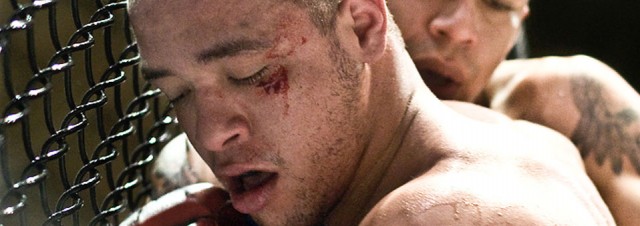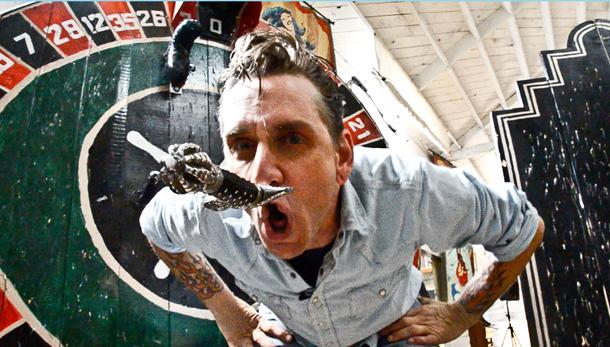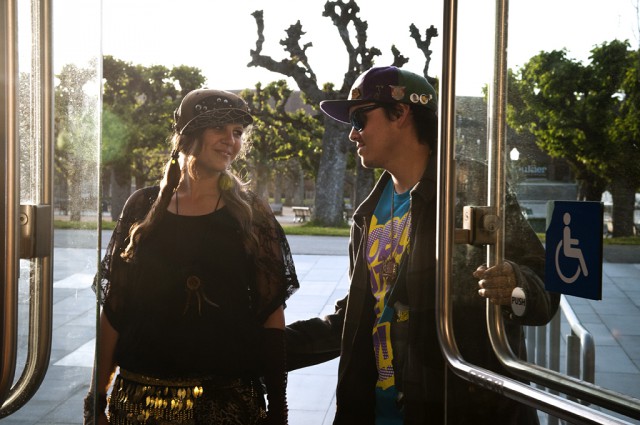Written by Ivanna Quiroz Photos by Godofredo Vasquez
Ten minutes until face off and the brown wooden benches of the Kezar Pavilion are quickly filling up. Outfitted with black Beats headphones, the DJ bobs his head up and down to mostly hip hop and some hard rock. Hoards of people enter, some juggle nachos, hot dogs, and energy drinks – most in clusters, and most clad in t-shirts supporting their gym or favorite fighter. Some groups are happy, cheerily chatting with one another, while others strut back and forth from one side of the arena to the other, game face on.
The star of this production, the cage, sits in the center, surrounded by cushioned blacks seats that constitute the “VIP area.” For the moment, the cage is empty. Its gray floor is clean and its padded corners shiny. For the spectators in the arena, the cage is unassuming, even though in just a matter of minutes, it will transform into a place of chaos. For the fighters waiting to enter, the cage is intimidating, threatening. For within the confines of this hexagonal structure, their fate will be decided. There is always one winner and one loser.
Zhong Luo, the owner of Dragon House, quickly appears for a few seconds and just as quickly disappears, talking urgently through his blue-tooth ear piece. Zhong Luo, or “Sifu” as he is called by his fighters, began learning martial arts at age three from his father and Grandmaster Luo Rong Qiang. By the age of five, Zhong Luo was already winning awards in hand-form competitions. When Luo was fourteen, he was well practiced in San Shou (Chinese kick-boxing), Mongolian-style wrestling, and weight-lifting.
Dragon House security begins to circle the pavilion on the lookout for any trouble makers ready to start a fight. Police officers and paramedics are present . The crowd is getting restless. Some head over to the biergarten while others stay glued to their seats knowing the event will begin soon. At 6:05, the lights dim, except those that illuminate the cage. The announcer enters.
“Ladies and gentlemen, Welcome to Dragon House 9!”
This is Dragon House 9, the only cage fighting event in San Francisco. The event is hosted by the Dragon House school in the city’s Mission district. Thirty fighters – eighteen amateur, twelve professional – from twenty-one different gyms will engage in fifteen grueling matches today.
Toby Fuentes, the first one to fight for Dragon House, waits in the locker room. He is eighteen years old and today is his first fight. He feels excited and eager to show off his skills in the cage.
Days before the fight, Fuentes trains at the Dragon House gym. The gym is easy to spot from the outside with a large, colorful mural captivating those who pass by. Once inside, the cage is the center. Though it’s smaller than a normal cage, it dominates the room. Punching bags line two walls opposite a large mirror. On the ground lays a bright blue and red mat – no shoes allowed. Chinese script lines the walls. Fuentes trains almost every day, including afternoons, nights, and weekends – whenever his busy schedule at the City College of San Francisco allows. For Fuentes, it’s basically “school, train, sleep, and repeat.”
“I started training in MMA in Reno, Nevada,” explains Fuentes. “I was in a boys home and one of the counselors, Larry Hall, asked me to try it out. I was about fourteen, fifteen years old.”
Fuentes has been training for about three to four years and he hopes to one day become a professional fighter in the Ultimate Fighting Championship. He revels in the challenge of MMA, and it is one of the many reasons he loves the sport. The lessons Fuentes take away from MMA will stay with him for the rest of his life.
“Discipline,” he says. “It has showed me that the guy who is the smartest and the most disciplined fighter will win eight times out of ten.”
Back inside the Kezar Pavilion, Fuentes gets ready to face off against opponent Rizaldy Celi Jr. from Cung Le’s AKA. The contenders enter the arena area and make their way through the crowd – their entourage bobbing up and down around them, and quickly apply Vaseline and furiously pump their fighters with words of encouragement. Seconds before the bell rings to sound the start of the fight, Fuentes bounces effortlessly around the cage, fists casually punching the air in front of him. He looks incredibly comfortable in the ring for a first timer.
The bell sounds and the fight begins. Round one: Fuentes gets kicked in an illegal move near his crotch – the referee allows him a few seconds to shake it off. Fuentes comes back quickly, knocking Celi on the ground, trapping him to the edge of the cage. Celi swiftly counter attacks and pins Fuentes against cage. Horns sound the end of the round. The fighters’ entourage enter with stools for Celi and Fuentes to sit on. The entourage supplies their fighters with water and reapply Vaseline on their face. A blond woman clad in a black bathing suit circles the ring and lifts a sign high in the air signaling the start of the next round. Hoots, hollers, and cat calls sound from the crowd.
Ding, Ding. Round two. Right away, Fuentes gets two punches in and pins Celi. Then, Celi wraps his legs around Fuentes and pins him. Round three: Celi pins Fuentes hard on the floor, but Fuentes quickly locks his legs around Celi’s neck. Horn sounds. The announcer enters the cage, declares a tie and lifts both fighters’ hands up.
“I was just happy that it was over with,” says Fuentes. “On TV, they don’t show you how fighters are after the fight. It’s mentally draining, but it was the best thing I have ever done.”
Mixed martial arts (MMA) is a full combat sport that includes techniques from boxing, wrestling, Brazilian jiu-jtsi, muay Thai, kickboxing, taekwondo, karate, judo, and numerous other styles. The roots of MMA can be traced back to the ancient Greek sport of Pankration, a blend of boxing and wrestling.
Pankration was introduced to the Olympic Games in 648 B.C. and was used in both sporting events and as a form of total combat for Greek soldiers. According to the mythology, Heracles (or Hercules) used Pankration to defeat the Nemean lion and Theseus used it to conquer the Minotaur in the Labyrinth. The practice of Pankration was incredibly violent and had no rules. If a competition resulted in death, it was considered a win. During the 1800s – 1900s, mixed style fighting was a happening all over the world – especially throughout Asia and Europe. The concept of mixing various types of martial arts was made popular in the West by Bruce Lee in the late 1960s and early 1970s.
“Actually, the father of mixed martial arts, if you will, was Bruce Lee,” explains Dana White, UFC president. “If you look at the way Bruce Lee trained, the way he fought, and many of the things he wrote, he said the perfect style was no style. You take a little something from everything. You take the good things from every different discipline, use what works, and you throw the rest away.”
In 1985, an MMA organization, Shooto, was established in Japan. But it was the Brazilian combat sport of Vale Tudo, developed in the 1920s by the Gracie family, that brought the sport to the United States. In 1993, Vale Tudo’s popularity led to the creation of the UFC, the world’s largest MMA promotion company today.
MMA is a difficult sport and takes an enormous amount of dedication. Take it from Christopher “CJ” Hagerty, a professional fighter at Dragon House. Hagerty has been fighting twenty hours a week for eight years, but it was no easy task becoming a pro. Hagerty began training in New Hampshire when he was about ten years old, stduying various types of martial arts. In 2004, he moved to Georgia and joined a gym called Knuckle Up where he met some Brazilian fighters.
“Dragon House was in my path, part of my destiny,” says Hagerty. “I’m very spiritual, and I found myself there after a lot of praying. Before I found a place to live, Sifu let me stay at the school for a couple of weeks. MMA is a big part of my life. I love my team.”
Fighting throughout his youth, MMA is something that comes naturally to Hagerty. He was very competitive in sports and dreamed of becoming a professional athlete. Hagerty plans to climb the ranks professionally and hopes to eventually be one of the top 5 in the world.
“I love the competition, and the fighting chance that we have to let it all hang out and prove ourselves worthy of our next fight,” explains Hagerty. “Always be the aggressor. Push the pace in training, and stay ahead in the fight. Think about survival, because it’s not a game in there.”







the extreme sports agent • Jul 14, 2014 at 4:36 pm
Thank you for sharing your info. I truly appreciate your efforts and I am waiting for your next post
thank you once again.